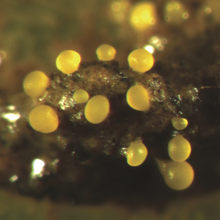Myxobacteria
| Myxobacteria | |
|---|---|

| |
| Myxococcus xanthus | |
| Scientific classification | |
| Kingdom: | |
| Phylum: | |
| Class: | |
| Order: | Myxococcales
|
The myxobacteria ("slime bacteria") are a group of bacteria that usuallly live in the soil. They feed on insoluble organic substances. They have very large genomes compared to other bacteria.[1] Myxobacteria are included in the delta group of proteobacteria, a large group of Gram-negative forms.
Myxobacteria move by gliding on the surface. They travel in swarms with many cells kept together by intercellular molecular signals. The swarm puts out extracellular enzymes to digest food. This increases feeding efficiency.
Life cycle[change | change source]
When nutrients are scarce, myxobacterial cells aggregate into fruiting bodies.[2][3] These fruiting bodies are different shapes and colours, depending on the species.
Inside the fruiting bodies, cells develop into rounded myxospores with thick cell walls. These myxospores, like spores in other organisms, survive until nutrients are more plentiful. Then cell growth is restarted with a group (swarm) of myxobacteria, not just isolated cells. Similar life cycles have developed among the amoebae called cellular slime moulds.
Uses[change | change source]
Myxobacteria produce a number of biomedically and industrially useful chemicals, such as antibiotics, and export those chemicals outside of the cell.[4] Some myxobacteria are used as model organisms for the study of development. At a molecular level, initiation of fruiting body development is regulated by Pxr sRNA.[5][6]
References[change | change source]
- ↑ Sorangium cellulosum has the largest bacterial genome at 13.0 million nucleotides. Schneiker S; et al. (2007). "Complete genome sequence of the myxobacterium Sorangium cellulosum". Nature Biotechnology. 25 (11): 1281–1289. doi:10.1038/nbt1354. PMID 17965706. S2CID 15425510.
- ↑ Kiskowski MA, Jiang Y, Alber MS (2004). "Role of streams in myxobacteria aggregate formation". Phys Biol. 1 (3–4): 173–83. Bibcode:2004PhBio...1..173K. doi:10.1088/1478-3967/1/3/005. PMID 16204837. S2CID 18846289.
{{cite journal}}: CS1 maint: multiple names: authors list (link) - ↑ Sozinova O.; et al. (2005). "A three-dimensional model of myxobacterial aggregation by contact-mediated interactions". Proc Natl Acad Sci USA. 102 (32): 11308–12. Bibcode:2005PNAS..10211308S. doi:10.1073/pnas.0504259102. PMC 1183571. PMID 16061806.
- ↑ Reichenbach H (2001). "Myxobacteria, producers of novel bioactive substances". J Ind Microbiol Biotechnol. 27 (3): 149–56. doi:10.1038/sj.jim.7000025. PMID 11780785. S2CID 34964313.
- ↑ Yu Y.T; Yuan X. & Velicer G.J. (2010). "Adaptive evolution of an sRNA that controls Myxococcus development". Science. 328 (5981): 993. Bibcode:2010Sci...328..993Y. doi:10.1126/science.1187200. PMC 3027070. PMID 20489016.
{{cite journal}}: CS1 maint: multiple names: authors list (link) - ↑ Fiegna F.; et al. (2006). "Evolution of an obligate social cheater to a superior cooperator". Nature. 441 (7091): 310–4. Bibcode:2006Natur.441..310F. doi:10.1038/nature04677. PMID 16710413. S2CID 4371886.
